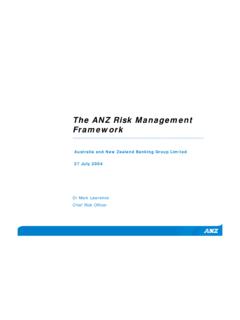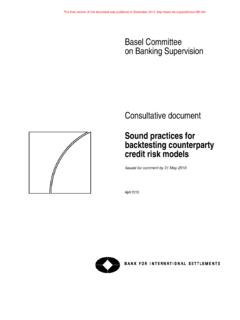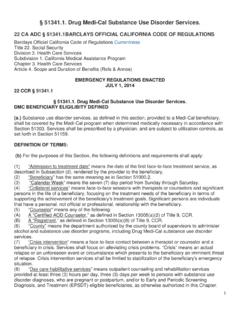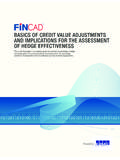Transcription of Counterparty Credit Risk (CCR) and Collateral …
1 Counterparty Credit Risk (CCR) and Collateral management in the light of Basel III, Basel and EMIR. Prof. Dr. Martin Hellmich Frankfurt School of Finance & management February 2015. New Regulation of OTC Derivative Markets All standardized OTC derivative contracts should be traded on exchanges or electronic trading platforms, where appropriate, and cleared through central counterparties by end-2012 at the latest. OTC derivative contracts should be reported to trade repositories. Non-centrally cleared contracts should be subject to higher capital requirements.. Grafik: PWC. Frankfurt School of Finance & management gGmbH 2 2. Context New Regulatory Framework Default Risk and Migration Risk Markets: MIFID II, MIFIR, EMIR.
2 CCP versus OTC. Banks: Basel , III, , SSM, Default Risk: Basel II Framework SRM,etc. enhanced by correlation multiplier and Funds: AIMFD, AIMFR, UCITS. stressed EEPE. Insurance Companies: Solvency II. Migration Risk: Credit Valuation IFRS: 9-13, Good Will, Leasing Adjustment (CVA). EU-Supervisory Framework: EBA, Funding Cost Modelling : DVA, FVA. ESMA, EIOPA, ESRB. Counterparty Collateral : Higher Collateral USA: Dodd-Frank Act, Volcker Rule Regulation Credit requirements on non-cleared trades, Central Clearing: USA. EU, Japan, initial margin requirements Hong Kong, Australia & Canada, Risk (CCR). Pre & post trade transparency Singapore, etc. New capital charges: reduce bank CCPs, OTFs, Trade Repositories capacity and widen spreads ISDA.
3 Mandatory clearing : apply to Trades between financial institutions, Credit Events : Bankruptcy, Failure to pay, Corporate groups which exceed usage Restructuring, Repudation/ Moratorium, thresholds Obligation and Acceleration Default, OTC-Derivative Legal Government Bail in Key factors in an instrument being Markets Framework Big Bang and Small Bang Protocols capable of being cleared: Standardisation [product, legal, process] ISDA 2003 versus ISDA 2014. Liquidity ISDA Master Agreement and Schedule: Risk management /modelling Single Agreement Philosophy Capital costs of bilateral trades drives Credit Support Annex (CSA). down volumes for non-cleared trades Valuation : Move from LIBOR Discounting Significant change in the business to OIS Curves model and organisation structure for 2012 ISDA Margin Survey: 71% of OTC.
4 Dealers derivatives trades were subject to Collateral Clearing will absorb significant high agreements, 83% of these required grade Collateral Collateral to be posted in both directions Frankfurt School of Finance & management gGmbH 3. Counterparty Credit Risk: CVA\ Downgrade losses substantially exceeded default losses. Defaultable Derivatives: Loans Deutsche Bank Deposits Bank A enters into Payerswap with DB: Trading Notional: 100m , book Capital Maturity: 5Y CVA-Cap. CDS-spread CP: 100. bp Total capital charge Counterparty Credit Risk (CCR). + 2. Counterparty migration 1. Counterparty default risk risk Mark-to-market losses due to Credit valuation adjustments (CVA) were not directly capitalised.
5 Roughly two-thirds of CCR losses were due to CVA losses and only one-third were due to actual defaults. (BCBS, 2009). Reforms: (i) Mandatory central clearing of standardised OTC derivatives (ii) Mandatory margining (IM0 and VMt) for OTC-derivatives if the 2 contract partners are banks and/. or systematically relevant Non-financials. IM0 is a major challenge as new, gross and restricted re- use. Sophisticated internal margin models or (very) conservative regulatory margins (iii) Bank capital requirements for derivatives-related exposures Frankfurt School of Finance & management gGmbH 4. Counterparty Credit Risk: CVA\ Motivation A derivative contract can have a positive or a negative market value Derivatives with a positive value constitute a claim to the Counterparty If the Counterparty defaulted, the loss would be the replacement cost of the contract ( the current market value).
6 A derivative contract with a defaultable Counterparty is less worthy than a contract with a risk-free Counterparty The lower the creditworthiness of the Counterparty , the lower the market value of the contract. The value of derivative contracts decrease, if the Counterparty becomes riskier ( an obvious indicator is a downgraded). Note: the value decreases even if all market parameters have not changed! Massive (unexpected) downgrades of counterparties (like the large investment banks in 2007/09) generate large migration losses in derivative trading books. These losses have not been backed with capital under Basel II, but have to be backed with capital under Basel III. The default risk of these contracts has been covered under Basel II.
7 Frankfurt School of Finance & management gGmbH 5. Counterparty Credit Risk: Motivation of Basel III - amendments .. by a better understanding of wrong- More adequate capitalisation of Credit way risks (stressed exposures). Counterparty risks as under Basel III. introducing CVA-risk charge Provide Incentives to move from OTC low risk weights for CCP-derivatives: transactions to central counterparties Default risk: 2%, (CCPs) Migration risk: 0%. Motivation Account for systemic risk, asset value correlation multiplier interconnectedness and procyclicality new qualitative requirements for Reduce Operational risks back and stress testing Frankfurt School of Finance & management gGmbH 6.
8 Counterparty Credit Risk: All Basel III-amendments regarding Counterparty Credit risk. Proposed remedies to better account for Counterparty Credit risk (CCR). Current treatment (A) CPPs (B) OTC. is insufficient : (i) Regulatory capital calculation (ii) CCR. Micro level Macro level management MtM- Qualitative down- CVA risk New Capital requirements for back CVA = 0 and stress testing grade risk charge Multiplier for asset value correlation wrong-way Stressed R: monitoring general (un- risk effective EPE wrong-way risk expected) Tackle shortcomings Default in alpha estimation risk Collatera- Risk weight = Margin Improve op. perf. of (accounted lised CCPs 2%*8% period of risk Collateral dept.)
9 For currently New guidelines for Reduce reliance on by Basel II) Reliance inferred ratings and external ratings and on external appropriateness of code of conduct for ratings unrated positions rating agencies back & Qualitative Model requirements for back stress validation and stress testing testing Incentives to move from For both, IM and SM. OTC to CCP. Only for IM. transactions Frankfurt School of Finance & management gGmbH 7. Framework for OTC-Derivatives Increased electronification of certain product markets continue, catalyzed by regulatory demands ( IR Swaps, CDS). Due to illiquidity in certain asset markets, investment banks still feature as broker-dealers in market making role as an important price generation entity Client Transaktion Repository Investment Banks EQ FI Comm FX.
10 Elektronic Trading Platform Inter-dealer Brokers Bilateral CCPs Clearing Standardised Deals Non-standardised Deals Source: Oliver Wyman Frankfurt School of Finance & management gGmbH 8. Institutions in the network of OTC derivatives exposures (BIS 2013). Macroeconomic impact assessment of OTC derivatives regulatory reforms Connectivity assumptions: The G-16 dealers have exposures to one another with probability 100%. The G-16 dealers have exposures to other dealers with probability 50%, and vice versa. Other dealers have exposures to one another with probability 25%. Frankfurt School of Finance & management gGmbH 9. The network perspective Macroeconomic impact assessment of OTC derivatives regulatory reforms (BIS, August 2013): network study featuring 41 banks, including the 16 largest derivatives dealers (G-16 dealer) to mimic the structure of the OTC.





